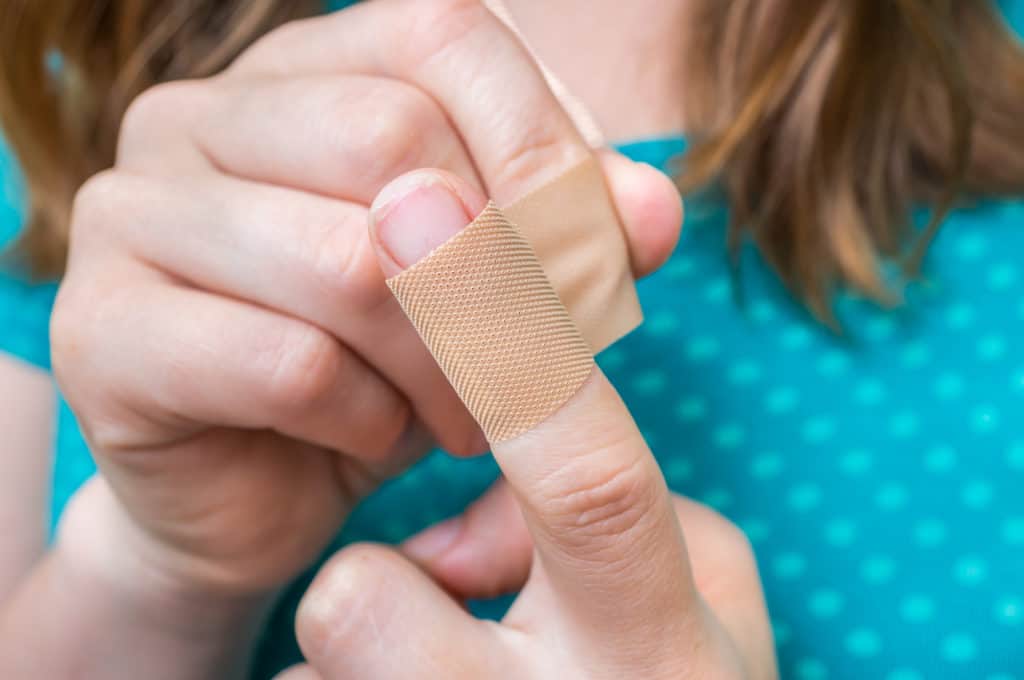Wounds can be a source of pain and discomfort, but they can also be a source of a bad smell. If you or someone you know has experienced a wound with a foul odor, you may be wondering why this is the case.
Here Is Why Wounds Smell Bad:
Wounds can have a bad smell, and this can protrude terrible smells. These smells that include cheese, fish and ammonia can be due to bacterial infections or tissue breakdown. This is the short answer!
In this blog post, we will explore the various reasons why wounds smell so bad and what can be done to alleviate this unpleasant smell. From bacteria and infection to necrosis and tissue breakdown, there are several factors that contribute to the smell of a wound. Understanding these reasons can help us better understand how to care for our wounds and promote faster healing. So, let’s dive into the world of wound odour and discover what causes it and how to manage it.

Reasons Why Wounds Smell So Bad
Cheese
Wounds can be a source of pain and discomfort, but they can also be a source of a bad smell. One of the most common complaints associated with wounds is that they smell like cheese. This odor can be caused by a variety of factors, including bacterial infection, necrosis, and tissue breakdown.
Bacterial infection is one of the most common causes of wound odor. When bacteria enters a wound, it can cause an infection that leads to the release of foul-smelling compounds, such as hydrogen sulfide and ammonia. These compounds can give off a strong, cheese-like odor. Additionally, certain types of bacteria, such as Pseudomonas aeruginosa, can produce a distinct, cheese-like smell.
Necrosis, or the death of tissue, can also cause a wound to smell like cheese. As cells die, they release enzymes and other compounds that can give off an unpleasant odor. Additionally, necrotic tissue can attract bacteria and other microorganisms, which can further contribute to the smell.
Tissue breakdown is another factor that can cause a wound to smell like cheese. As the body breaks down and removes dead cells and other debris from the wound, it can release foul-smelling compounds. Additionally, enzymes and other substances produced by the body to aid in the healing process can also contribute to the smell.
In summary, wounds can smell like cheese for many reasons, including bacterial infection, necrosis, and tissue breakdown. Understanding these underlying causes can help us better understand how to care for our wounds and promote faster healing. It is important to note that if the wound has a bad smell and is not healing properly, it is important to consult with a healthcare professional. They may recommend further treatment such as antibiotics or wound debridement.
Fish
Wounds can emit a strong, fishy odor due to the presence of certain bacteria. These bacteria release compounds called trimethylamine (TMA) and putrescine, which are responsible for the distinct smell.
Here are 5 key points on why wounds smell like fish:
1. The bacteria present in wounds, particularly those that thrive in anaerobic environments, release TMA and putrescine as a byproduct of their metabolism. This can lead to a strong fishy odor.
2. The severity of the wound, as well as the presence of necrotic tissue or other debris, can also contribute to the fishy smell.
3. Infections, such as cellulitis or necrotizing fasciitis, can also produce a fishy odor due to the presence of bacteria and the release of TMA and putrescine.
4. People with diabetes or other conditions that impair circulation to the extremities may be at increased risk of developing wounds with a fishy odor due to the presence of anaerobic bacteria.
5. Treatment for wounds with a fishy odor typically includes wound debridement and antibiotics to eliminate the bacteria responsible for the smell. It’s important to address the underlying cause of the wound and maintain proper wound care to prevent further infections.
It’s important to note that the fishy odor from the wound is not an indication of the wound healing, but rather a sign of the presence of bacteria which should be treated with proper wound care and antibiotics.

Dead Animal
Wounds can emit a strong, unpleasant odor that may resemble the smell of dead animals. This odor is usually caused by the presence of bacteria and the release of certain compounds as a byproduct of their metabolism.
Here are 5 key points on why wounds smell like dead animals:
1.The bacteria present in wounds, particularly those that thrive in anaerobic environments, release compounds such as sulfur compounds and cadaverine. These compounds are responsible for the distinct smell of a wound that resembles a dead animal.
2. The severity of the wound, as well as the presence of necrotic tissue or other debris, can also contribute to the smell.
3. Infections, such as gangrene, can also produce a smell that resembles a dead animal due to the presence of bacteria and the release of sulfur compounds and cadaverine.
4. People with diabetes or other conditions that impair circulation to the extremities may be at increased risk of developing wounds with a smell like a dead animal due to the presence of anaerobic bacteria.
5. Treatment for wounds with a smell like a dead animal typically includes wound debridement and antibiotics to eliminate the bacteria responsible for the smell. It’s important to address the underlying cause of the wound and maintain proper wound care to prevent further infections.
It’s important to note that the smell of a dead animal from the wound is not an indication of the wound healing, but rather a sign of the presence of bacteria which should be treated with proper wound care and antibiotics.
-
Kreme Plus 50gm$22.00
Rotten
Wounds can emit a strong, unpleasant odor that may resemble the smell of rotting flesh. This odor is usually caused by the presence of bacteria and the release of certain compounds as a byproduct of their metabolism. The bacteria present in wounds, particularly those that thrive in anaerobic environments, release compounds such as sulfur compounds and cadaverine. These compounds are responsible for the distinct smell of a wound that resembles rotting flesh.
The severity of the wound, as well as the presence of necrotic tissue or other debris, can also contribute to the smell. Infections, such as gangrene, can also produce a smell that resembles rotting flesh due to the presence of bacteria and the release of sulfur compounds and cadaverine. People with diabetes or other conditions that impair circulation to the extremities may be at increased risk of developing wounds with a smell of rotting flesh due to the presence of anaerobic bacteria.
Treatment for wounds with a smell of rotting flesh typically includes wound debridement and antibiotics to eliminate the bacteria responsible for the smell. It’s important to address the underlying cause of the wound and maintain proper wound care to prevent further infections. It’s important to note that the smell of rotting flesh from the wound is not an indication of the wound healing, but rather a sign of the presence of bacteria which should be treated with proper wound care and antibiotics.
In addition, the smell of rotting flesh can also be a sign of underlying issues such as necrosis, where the tissue is dying due to lack of blood flow. This can progress to a severe stage of infection called gangrene, which can lead to amputation if not treated promptly. Therefore, if you notice any smell of rotting flesh coming from a wound, it’s important to seek medical attention as soon as possible.

Amonnia
Wounds can emit a strong, unpleasant odor that may resemble the smell of ammonia. This odor is usually caused by the presence of bacteria and the release of certain compounds as a byproduct of their metabolism. The bacteria present in wounds, particularly those that thrive in anaerobic environments, release compounds such as ammonia as a byproduct of their metabolism. These compounds are responsible for the distinct smell of a wound that resembles ammonia.
The severity of the wound, as well as the presence of necrotic tissue or other debris, can also contribute to the smell. Infections, such as cellulitis, can also produce a smell that resembles ammonia due to the presence of bacteria and the release of ammonia. People with diabetes or other conditions that impair circulation to the extremities may be at increased risk of developing wounds with a smell of ammonia due to the presence of anaerobic bacteria.
Treatment for wounds with a smell of ammonia typically includes wound debridement and antibiotics to eliminate the bacteria responsible for the smell. It’s important to address the underlying cause of the wound and maintain proper wound care to prevent further infections. It’s important to note that the smell of ammonia from the wound is not an indication of the wound healing, but rather a sign of the presence of bacteria which should be treated with proper wound care and antibiotics.
In addition, the smell of ammonia can also be a sign of underlying issues such as urine incontinence or urine infection. Therefore, if you notice any smell of ammonia coming from a wound, it’s important to seek medical attention as soon as possible to rule out any underlying conditions.
-
Kreme Plus 150gm$37.00
Easy Ways To Get Rid Of Wound Odour
Change Band aids Regularly
One of the easiest ways to get rid of wound odor is by regularly changing the bandages on the wound. Bacteria can easily grow on a wound that is covered with a dirty or damp bandage, which can lead to an unpleasant smell. By keeping the bandages clean and dry, you can prevent the growth of bacteria and reduce the risk of infection.
To get rid of wound odor, it is important to change the bandages at least once a day, or more frequently if the wound is producing a lot of exudate. Before applying a new bandage, it is important to clean the wound with soap and water and then dry it thoroughly. Using an antiseptic solution such as hydrogen peroxide or iodine can also help to kill bacteria and reduce the risk of infection.
Another way to get rid of wound odor is by using a wound care ointment or cream that contains an antimicrobial agent. These products can help to eliminate bacteria and reduce the risk of infection.
In addition, it’s important to ensure the wound is kept moist, as dry wound tend to heal slowly, may be painful and can form scabs that can trap bacteria and bad odours. Therefore, it’s important to keep the wound moisturized with a moisture-locking bandage or a hydrogel dressing.
It’s also important to note that if the wound is infected, it’s important to seek medical attention and get the wound treated by a healthcare professional.

Antibacterial Wash
One of the easiest ways to get rid of wound odor is by regularly cleaning the wound with an antibacterial wash. Bacteria can easily grow on a wound, leading to an unpleasant smell and increasing the risk of infection. By using an antibacterial wash, you can kill the bacteria and reduce the risk of infection.
To get rid of wound odor, it is important to clean the wound with an antibacterial wash at least once a day, or more frequently if the wound is producing a lot of exudate. Before applying a new bandage, it is important to clean the wound with soap and water and then dry it thoroughly. The wound can be then cleaned with an antibacterial wash, which is known to be effective against a wide range of bacteria.
Another way to get rid of wound odor is by using wound dressings that contain an antimicrobial agent. These dressings can help to eliminate bacteria and reduce the risk of infection. It’s important to use the dressings as per the instructions of the manufacturer or the healthcare provider.
In addition, it’s important to ensure the wound is kept moist, as dry wound tend to heal slowly, may be painful and can form scabs that can trap bacteria and bad odours. Therefore, it’s important to keep the wound moisturized with a moisture-locking bandage
It’s also important to note that if the wound is infected, it’s important to seek medical attention and get the wound treated by a healthcare professional. A prolonged or severe wound odor, or other symptoms such as fever, redness, pain, or swelling, may indicate an infection and should be evaluated by a doctor.
-
Kreme Plus 50gm$22.00
Barrier Cream
One of the easiest ways to get rid of wound odor is by using a barrier cream to heal up the wound. Barrier creams are designed to protect the wound from bacteria, moisture, and other external factors that can cause an unpleasant smell. These creams can also help to promote the healing process, reducing the risk of infection and odor.
To get rid of wound odor, it is important to apply a barrier cream to the wound at least once a day, or more frequently if the wound is producing a lot of exudate. Before applying the cream, it is important to clean the wound with soap and water and then dry it thoroughly. Barrier creams, such as those containing Manuka Honey or Beeswax, can help to create a barrier over the wound, preventing bacteria and other contaminants from entering the wound.
Please check out our product Kreme Plus Kreme Plus which is a Manuka barrier cream.
In addition, it’s important to ensure the wound is kept moist, as dry wound tend to heal slowly, may be painful and can form scabs that can trap bacteria and bad odours. Therefore, it’s important to keep the wound moisturized with a moisture-locking bandage.
Check out a great article we did on Manuka honey for wound healing here.
It’s also important to note that if the wound is infected, it’s important to seek medical attention and get the wound treated by a healthcare professional. A prolonged or severe wound odor, or other symptoms such as fever, redness, pain, or swelling, may indicate an infection and should be evaluated by a doctor. A barrier cream can also be used in conjunction with other wound care methods, such as cleaning the wound with an antibacterial wash or using wound dressings that contain an antimicrobial agent.




